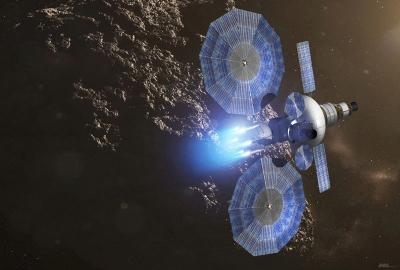Mon, Jan 27, 2014
System Projected to Provide 10 Times More Power than the Largest Current Satellite Solar Array Technology
Full deployment of a large MegaFlex solar array built by ATK under a NASA contract to further the development of a high-power system to be used for future robotic and manned exploration missions has been demonstrated by the company.

ATK's 32 ft diameter Solar Electric Propulsion (SEP) MegaFlex solar array design is capable of generating approximately 40kW of power with two wings when fully populated with solar cells, and it has been considered for near-term mission concepts such as NASA's Asteroid Redirect Mission. The full deployment demonstration of MegaFlex was successfully conducted at ATK's Goleta, Calf. facility on Dec. 9. The system completed validation testing through December before being shipped to NASA's Glenn Research Center Plum Brook Station for thermal vacuum deployment testing this month.
"NASA's over-arching objective is to further the development of low mass solar arrays that can be stowed very compactly for high-power SEP systems to be used for future robotic and manned exploration missions," said David Shanahan, vice president and general manager of ATK Aerospace Group's Space Components division. "By building on our family of solar arrays, our team was able to develop this breakthrough with affordable innovation and in rapid fashion to support NASA's far-reaching planning efforts."
ATK received a $6.4 million contract for the MegaFlex development in October 2012. The phase 1 SEP MegaFlex solar array Tech Development program goal is to further the maturity of an extensible (>250kW total) solar array structure through design development and validation testing, resulting in a technical readiness level of 5+ maturity in preparation for a non-specified Technology Demonstration Mission.
ATK's MegaFlex solar array is based on ATK's spaceflight-proven UltraFlex solar array family of platforms that powered NASA's Mars Phoenix Lander in 2008. The solar array is also in series production of 10 wings for Orbital Science's Commercial Resupply Services spacecraft and is base-lined on NASA's recently announced Insight Discovery Mission to Mars awarded to Lockheed Martin. The exceptional performance of smaller (6-foot diameter) solar arrays used to power the Phoenix Lander contributed to the Phoenix mission being extended three times.
The unique circular architecture of the UltraFlex and MegaFlex systems enables very low mass and small stowed volume for multiple space exploration missions. A follow-on Phase 2 Technology Development effort to further develop a flight-ready version of MegaFlex would support a future space flight demonstration to finalize an operational system.
(Image provided by ATK)
More News
Its Offerings Are Lighter, Cleaner, and Now Pushing Past 1,000nm on SAF Jet Fuel DeltaHawk’s diesel-powered aircraft lineup has seen incredible upgrades over the last few yea>[...]
The Airplane Experienced A Total Loss Of Engine Power On December 3, 2025, about 1600 central standard time, a Mooney Aircraft Corp. M20K, N57229, was substantially damaged when it>[...]
Make Sure You NEVER Miss A New Story From Aero-News Network Do you ever feel like you never see posts from a certain person or page on Facebook or Instagram? Here’s how you c>[...]
Aero Linx: European Society of Aerospace Medicine (ESAM) As a pan-European, independent forum, it works to promote the safety and health of all persons involved in aviation and spa>[...]
“We are excited to see Wisk achieve this milestone, and I’m so proud of the team that made it possible. The team at Wisk has built advanced technologies across flight c>[...]
 Aero-TV: DeltaHawks Diesel Power Steps Into the Spotlight
Aero-TV: DeltaHawks Diesel Power Steps Into the Spotlight NTSB Prelim: Mooney Aircraft Corp. M20K
NTSB Prelim: Mooney Aircraft Corp. M20K ANN FAQ: Turn On Post Notifications
ANN FAQ: Turn On Post Notifications ANN's Daily Aero-Linx (12.20.25)
ANN's Daily Aero-Linx (12.20.25) Aero-News: Quote of the Day (12.20.25)
Aero-News: Quote of the Day (12.20.25)



